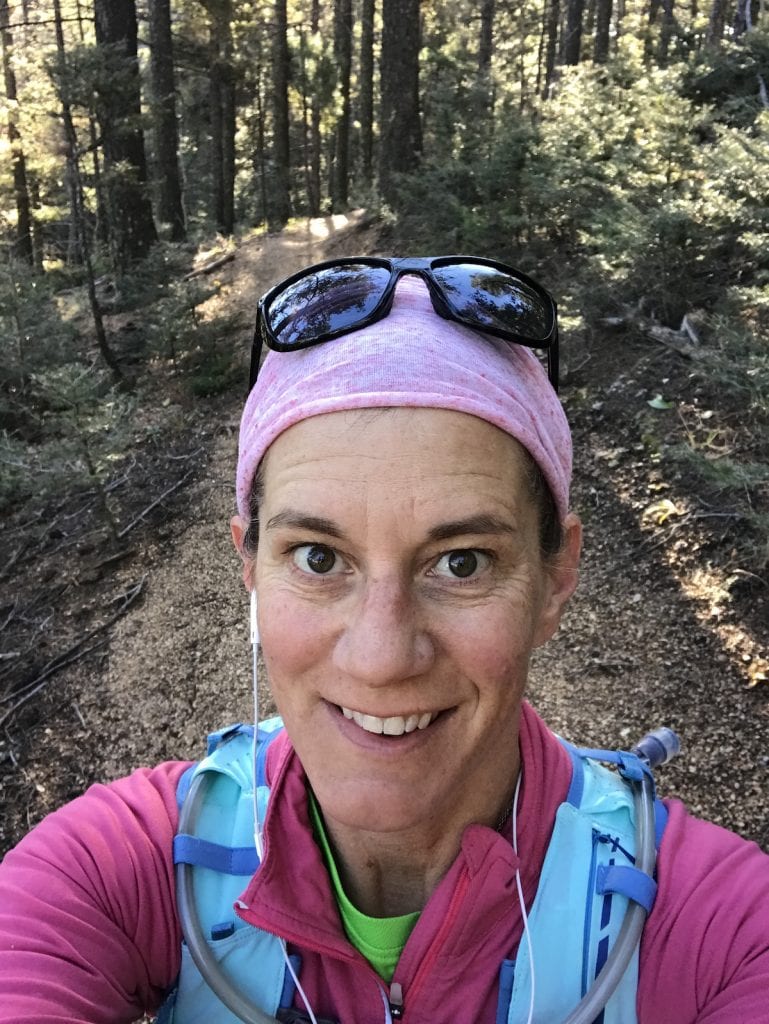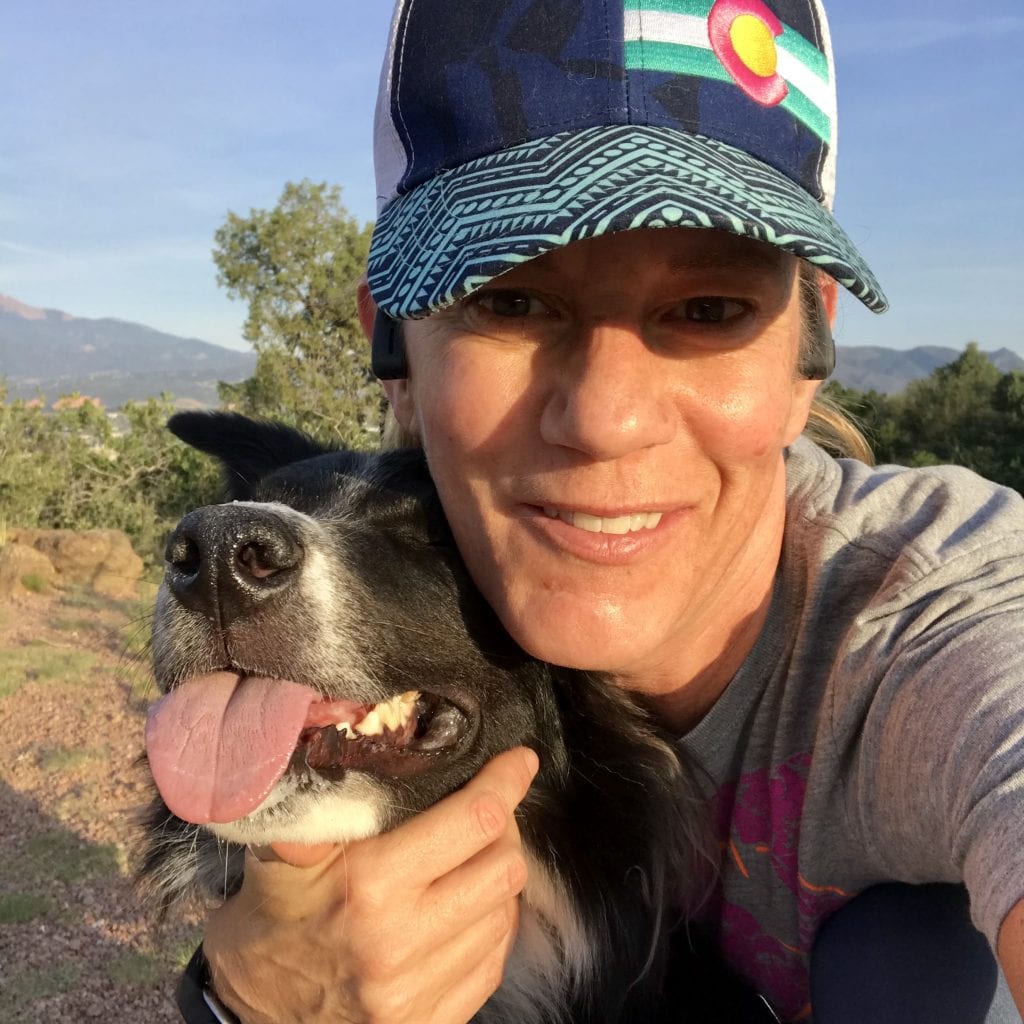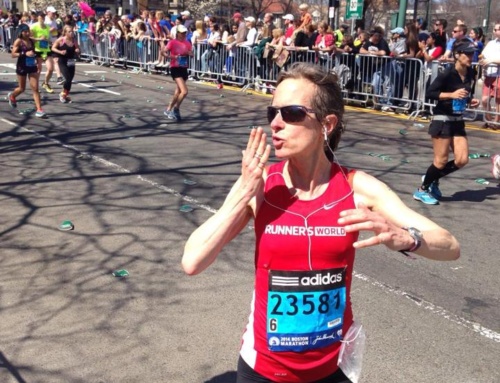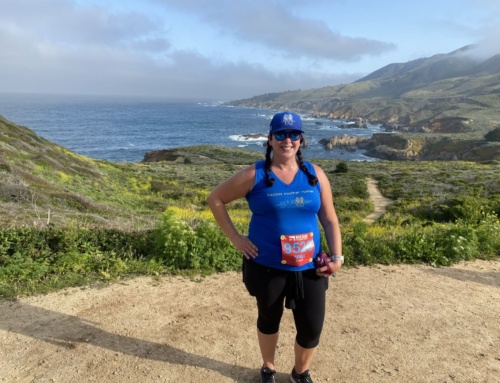
Cathy, on her beloved trails.
[[Happy to return to the Running Through It series; today, Cathy, a Colorado-Springs-based #motherrunner shares the story of her teenage daughter Lily, who suffers from anxiety + depression. “Lily has always told me it is ok to share her story,” says Cathy, “She wants others to know what living with anxiety and depression can be like.”]]
When my children were younger, the days were full of joy, energy, and play. We stayed busy with friends, library reading programs, hiking our favorite trails, messy craft projects, and knock-knock jokes. I tried to find the balance between not too busy and not too much down-time.
Really, I was like any other mom who was trying to do her best. And yet, when my daughter was 8 years old, a tiny voice whispered in the back of my mind, “I think there’s something wrong with Lily.”
When all you want is for your kids to be happy and healthy, that tiny voice scared me beyond words. And as another year or two went by, despite my best efforts to silence that voice, fear began to creep into my heart that, indeed, something was not right.
Lily, who had always been a spitfire and was adored for her strength, began to seem unable to control her anger. Her separation anxiety when she was away from me, which had seemed normal for a toddler, morphed into crippling anxiety about leaving our home. Her silly sense of humor, which had always entertained her peers, started to alienate her as she began to have a difficult time relating to others. By the time she was 10, we were seeking help with a counselor, and not long after that, while her world continued to deteriorate, a psychiatrist.
When Lily was in 5th grade, our lives imploded. At this point, her anxiety was so bad she could not go to school. Her anger was so random we were walking on eggshells. More days than not, she curled up on the couch and cried for hours on end. The diagnoses came with the weight of the world—Generalized Anxiety Disorder, Major Depressive Disorder, and probable Bipolar Disorder.
It was too much. She was suffocating. We were suffocating. The walls closed in.

Cathy’s best running dog, Pirate. When he’s not running with her, he gives Lily some much needed emotional support.
About this time, my running began to take on a more meaningful role in my life. I had been running since college, but always for fun and always casually. When Lily’s illness started to consume our family, running was no longer for fun, it became a necessity. To get outside and breathe fresh air, to feel my legs burn and my arms pump, to remember that I was someone outside of this miserable illness that was swallowing my daughter, and to prove that I could run 5 miles, 7 miles, 13 miles.
The more chaotic the mental illness symptoms were, the more diligent I became in practicing self-care through running. I failed miserably in self care in other ways, like letting people help us—this is a whole other issue entirely, but it’s hard to talk about mental illness still to this day, and people were put off by Lily’s symptoms—but I made sure I could still run, often getting up at 4 am when Lily was most likely to be asleep.
The past several years have been excruciating. Lily is enrolled in an online school so she can stay home, but she needs much assistance from me. Most of my day is spent as caretaker to her. Each week is filled with counseling appointments and therapy. We are on our 4th counselor and 3rd psychiatrist. Insurance is a nightmare, while psychiatrists and counselors switch practices, retire, and sometimes just aren’t a good fit. Most don’t take our insurance and we pay out of pocket. We have tried multiple medications, some with horrific side effects, and seen minimal success.
We have rearranged our lives, lost friends, ended family vacations, questioned our faith, enacted a suicide prevention plan, and learned not to plan for things more than 24 hours in advance. But the very worst of all is that Lily has been robbed of some of the best years of her life. She has had to watch former friends move on in the world, go to Homecoming and Prom, start to practice driving, and earn more independence. She wishes more than anything to not feel sad, to not feel anxious, to not feel incapable, to not feel worthless.
Lily is now 17, and I can happily say that she has experienced more stability from her illness recently. While other parents cheer their children’s grades or college acceptances, we cheer for Lily’s ability to walk into a store by herself and purchase something. We cheer for days she gets dressed and takes a walk. We cheer when we see her smile. We cheer her endless courage and relentless fight against a misunderstood and monster of a disease.
In a word, she is spectacular.
When it comes to mental illness, routine and health are vital. I have found that routine and health are vital for caretakers, too. Even better, for me, were running goals. During one of Lily’s harder years, I decided to begin heart rate training with the Train Like a Mother Club.
I ran my first marathon, and I was hooked with the training plans and accountability from so many other amazing BAMRs. On Lily’s worst days, when nothing went well, I could tell myself, “At least you got to run today.” I could continue to care for her because I had taken the time for myself. When my marathon training was finished, and my first marathon was successfully under my belt, I wanted more. More structure. More goals. More love.

After The North Face San Francisco 50k (6,700 feet of climbing and 32.4 miles). “I am damn proud of those numbers!” she says. #asyoushouldbe
Four training plans later and this fall I finished my first 50k, essentially giving mental illness the middle finger. I want to go longer, farther, higher, harder. “Come at me!” I inwardly scream at this disease. “You can’t stop us!” In 2019, I want to run my first 50 miler.
There is no end with this illness. There is no cure. We hope and pray for long seasons of stability, and we brace ourselves for when the bottom falls out. I doubt I will ever reach the finish line of this particular race, and that is why I am so, so grateful to be a BAMR and have other finish lines to cross. I celebrate them with you.
And to all the other mothers out there who are raising a child with ongoing medical needs: Run.
Buy the running shoes even when the medical bills pile up. Run.
Invest in a goal race to keep you looking forward to something. Run.
Run for your own sanity.
Just run.






I can’t even imagine what you & lily are going through, but thank you for sharing your story. You’ll help more people than you ever know.
Cathy, I’ve loved training beside you. Now that I know what has been fuelling your commitment to running, I am in awe. Thank you for sharing your story so generously. And please tell Lily that she has an army of BAMRs cheering her on.
Thank you so much for this, Cathy. My 8 year old son is displaying signs of anxiety, and we are just starting the process to find him a child psychologist to help him. You are right that this disease is so misunderstood and not many people “get it”. I’ll pray for you and your family.
Thank you so much for sharing your story Cathy. We are dealing with anxiety and depression in my youngest, and while not as extreme as your situation, all the words you have said are so true – the walking on eggshells, the heartbreak of not being able to fix things, the strain on the rest of the family. IT is wonderful to read someone else’s story, especially someone I have “known” since starting HRT almost two years ago. You are a rock and an inspiration!
Thanks for the great share.
Cathy, our son struggles from extreme anxiety, depression and also probable bipolar disorder. He is 20 years old and still living in our home. Our story sounds very similar to yours, and the struggles have been so incredibly real. Running has been spiritual and necessary for me for many years. Right now I’m in an injury phase and can’t run or do any cardio for a couple of weeks, and that as you know, makes it so difficult to manage stress. I hope that some day our son’s story, your daughter’s story, and others too will help open the lines of communication for finding support and resources for diseases that so many don’t understand.
Thank you for sharing your story and life. What inspiration and I can only imagine the challenges. I have close friends working through similar challenges and may share your story with them. Running is such a gift for us in so many ways and for so many reasons ..keeps me going too
Cathy, thank you to you and Lily for sharing your story with us.
Your story is so amazing and made me tear up. You are an inspiration to not only all of us but to your daughter. I wish Lily and your family all the best.
A powerful and heartbreaking story. Thank you for sharing your struggle. Sending love and light to Lily and everyone who loves her.
We have spent the last 9 months learning about depression through our 16 year old son’s illness. Both my husband and I ran through the worst days and felt like we got no benefit from a 45 minute sweaty run- like we never got that high, but we knew it was important to take care of ourselves. Like a BAMR wrote above, we are working to help our child become stable and gain more independence as his condition allows.
Prayers and patience to the moms in this situation. <3
Thank you for sharing this story in such a raw, authentic and emotional way. Being able to run is always a gift and we tend to forget that in the minutiae of our busy days. Your story reminds me to always appreciate the miles we accomplish.
Thank you for sharing your story. My son is almost 14 and the past year he has struggled with anxiety and so much more. Like you, I saw signs early on but couldn’t quite put my finger on it. This world feels so very isolated, it really helps to know that I am not alone.
My step daughter (age 30) suffers from anxiety depression. It’s an awful disease and at times (most times) loved ones feel almost helpless. I pray for her daily, her husband, kiddos and all others who go through such deep sadness. THANKS for sharing your story. You’re so strong and brave and I congratulate you on each and every victory daily! It’s a lot!
Oh Cathy … thank you so much for sharing. I read your post through tears. My 13 yo, Kate, also struggles mightily with anxiety and depression and has since they were in first grade. To read someone else’s account and see so many similarities and see how you are persevering is inspiring and heartbreaking at the same time. Your daughter is lucky to have you – a warrior Mama – on her side. Thank you for reminding us to keep going, keep running and keep pushing forward. Sending you hugs and strength and many happy miles.
Also reading your story (and Lily’s) through tears. My husband and daughter are both struggling with depression, anxiety, and bipolar diagnoses, with recent hospitalizations for both. Your post helped strengthen my resolve to find running again- its so easy to feel guilty about taking time for myself, but I recognize I need it. From the bottom of my heart, thank you.
My daughter’s anxiety, depression, and asperger-ish diagnosis came in 6th grade. She’s now going into her senior year and our family has had many trying times. At the same time we dealt with my mom and stepdad both dying in hospice, and I was hit by a car while running with my dog, and wasn’t able to run for a year. Life can be so overwhelming, but you’re not alone in this, hang in there, and please keep taking care of yourself. And thank you for sharing, helps me feel less alone.
I’m tearing up as I read this. Our 8 year old daughter is currently impatient again after less than a month from her last hospitalization. We are at the beginning of this journey and her diagnosis is not yet clear, but the failings of our mental health system are crystal clear. Thank you for sharing.
Cathy, I too have a son and daughter with depression, anxiety and ADHD. I truly feel your pain. Let me offer you some information about an organization that has a different approach to mental health care. Dr. Daniel Amen (of PBS fame) has helped to change our lives. Please do some research on him and consider getting your daughter to one of his clinics for a brain SPECT scan. Here is a starting point: https://www.amenclinics.com/
Another organization you may want to research is the Child Mind Institute, https://childmind.org/
Keep on running and stay strong warrior! Much love and support to you.
Thank you so much for sharing, Cathy, and for bringing a light to mental illness. I thought about sharing my own similar story when AMR called for stories. My son’s story sounds very similar: severe OCD, Bipolar, Generalized Anxiety Disorder, Major Depressive Disorder, and a couple of years with hospitalization and living 24/7 literally hour by hour trying to prevent suicide attempts, with my husband and I taking shifts for sleep so one of us could always be awake and monitoring. He is about to turn 17 and is currently in a more stable state, but we still know how quickly things can change. Therapy and psychiatrist visits consume less of our time now, but every day we are thankful for doses of normalcy. I, too, started running more when all of this started about 5 years ago. Just being able to leave the house was a daily gift. I hope you continue to see improvements and stabilization. It’s a tough road that people on the outside just can’t understand. I’ll keep you and your family in my prayers! Thank you again for sharing.